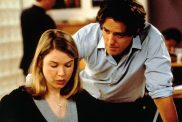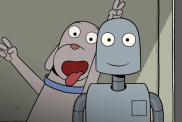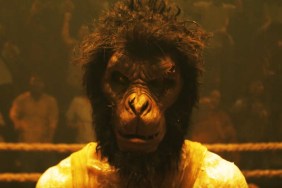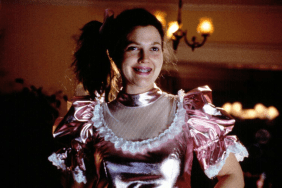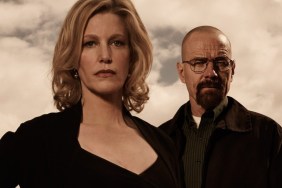Perspective and perception can be interesting things to play with in any medium, whether it’s television or cinema or other forms of writing. It’s a different story when you have to deal with the subjective aspects of any relationship, when two people who have an experience can’t agree on exactly what happened or how something played out, especially when it comes to that relationship falling apart or coming to an end.
These are some of the ideas being explored in director Ned Benson’s first feature film The Disappearance of Eleanor Rigby: Them, starring Jessica Chastain and James McAvoy as a married couple who drift apart after a tragic incident and are trying to move ahead with their lives despite having many common connections that remind them of what they had.
“Eleanor Rigby” debuted at Toronto as two entire feature films, subtitled “Her” and “Him,” since that was the way Benson originally envisioned the film as one story being seen from two different perspectives of the characters played by Chastain and McAvoy. As much as the film focuses on that duo, they’re surrounded by an amazing cast including Viola Davis, Ciaran Hinds, Bill Hader, Nina Arianda, Isabelle Hupert and William Hurt.
ComingSoon.net sat down with the writer/director more recently to talk about the origins of the film and how it evolved essentially into three separate but complementary movies, all of which will be available to watch theatrically over the next month.
ComingSoon.net: I’ve been tracking this project for a while now, obviously due to the high-profile casting, but also you shot in my neighborhood down on the Lower East Side.
Ned Benson: Oh cool, yeah. We shot a lot down there.
CS: I remember seeing a sign and wondering, “Oh, what’s this? This is a kind of interesting name for a movie.” I looked it up and was like, “Oh okay. It’s that movie.” Unfortunately, I missed it at Toronto last year so I haven’t had a chance to see “Him” or “Her” yet, but I do plan to.
Benson: I’m glad you’ve seen it this way, because I think it’s more expansive as opposed to reductive, to see “Them” first. Then, all these characters sort of open up a little bit more as opposed to the other way, which I think is a bit reductive, seeing the wider, more expansive version first.
CS: I was curious about that since I know when you were developing the film, the whole idea was to show a relationship from two different sides. When I heard you made a new movie out of the two of them, I wasn’t sure how that might work, since you obviously shot the movie with something very specific in mind. Then you went into editing and created something different. I know the story of how you met Jessica and how you wanted to do something together, but what started this particular idea?
Benson: Well, I think I wanted to make a love story in general, and ultimately, just through conversations with Jess and my producer Cassandra Kulukundis. I had written the sort of first part of the script, which was “Him.” Jess started asking me all these questions, and then it sort of was the impetus for me to write “Her.” That became really exciting, because all of a sudden we’re making a movie about subjectivity in a relationship and how a relationship itself is two completely subject perspectives. That to me felt like I could feel more of the whole relationship as opposed to following one protagonist and like the back and forth. Then, I could create specific looks for each of these worlds and specific feels for each of these characters. So ultimately, what I started with was two separate character studies that ultimately would be this complete film, this complete story.
After finishing that, which obviously played really well and got picked up at Toronto, which was exciting, I think the big question was like, “How are we going to get audiences to go see a three hour and 10 minute movie? What are our options?” I had been asked the question, “Would you ever combine them? Would you ever do this?” I sat in an editing room and had to kind of see if it worked, and it did work. I think I had to make a new movie, in a sense, even though it’s part of this whole, I couldn’t use the ideas of perspective and memory and the themes that existed in “Him” and “Her.” I sort of had to create a film about two people who lost the ability to communicate with each other, ultimately find synthesis. So what I wound up doing is I used the cool hues and the more fluid camera rhythms of his film and the warm and looser camera rhythms of her film, and sort of created disparate, I guess, languages and visual spaces for each of them. I ultimately, found a synthesis within that single film and sort of made it more about two people who had lost the ability to find their language together and ultimately find it again.
CS: I know you met Jessica about 11 years ago. How long ago did you actually start writing this and come up with the idea?
Benson: I started writing the first script when I was 27. I’m 37 now.
CS: Working on something as long as this, I wondered if your own perspective may have changed while writing it. Did you get married in the time since you started working on it?
Benson: I’ve been in relationships, but I haven’t been married, no. Jessica and I were together during the writing of the project and the creation of the project, so it was fun as a couple to sort of create this thing.
CS: Oh, that answers one of my questions, because knowing you met her so long ago I wasn’t sure how you were still able to get Jessica to star in the movie considering how she had blown up in the years leading up to you finally making it.
Benson: Yeah, as you mentioned, we met so long ago and we just had a very creative relationship and I was very supportive of her stuff and she’s very supportive of mine and we were both struggling–a struggling actress and a struggling writer/director. I think we were just supportive of each other and the belief in each other was kind of one of the exciting things about this, and then building this thing together with my friend Cassandra, who wound up being the producer, it was a really exciting thing. To have it actually come to fruition, the project itself sort of brings to the front or the forefront the scale of our lives, in a weird way, so yeah.
CS: It’s a great project for her. She’s obviously a great actress, but it really showcases how talented she really is, as it does for James.
Benson: Yeah, I mean, they’re both beautiful actors and work so differently, but I loved watching what Jess did in this movie, because I haven’t see her be as vulnerable as she was in this. I just loved watching her act, period. It was like a master class. She’s so talented and it’s this reservoir of feeling that is pretty amazing.

CS: I’ve met her a couple of times and one thing I’ve always liked about her is that she keeps in touch with her friends and ends up working with them when possible.
Benson: Well, her best friend from Juilliard plays her sister in the movie, too: Jess Weixler, so yeah, there was that as well. So a bunch of friends making this movie.
CS: In “Them,” it definitely seems to be more focused on her than it is on him. James has some great scenes in the film as well, but did you realize that while working on the new edit that it was going to be more about her character than his?
Benson: Look, it was a great lesson in editorial. I had to get in an editing room and see what was working and in the combination of these films, which scenes all of a sudden work within the rhythm of what you’re trying to edit together and actually can be part of this film. You know, you just have these like gut things that happen, where you sort of start to see the through lines of the film and the scenes that are working and that are not. And to me, that’s just sort of the way it happened. The “Her” script was actually longer, so there were scenes that I think thematically resonated better within this context as opposed to the separate films “Him” and “Her.” And you know, I tried to fit in all these other scenes that are in “Him,” and they only worked within the context of his film. Like Ciaran Hinds’ character is like a really big character in this film and he’s got a bunch more scenes. But like, they didn’t necessarily work. They didn’t focus the film, you know, the way that I needed it to, and it’s the same with a couple of other characters as well. I just wanted to really focus on like, the two of them and the back and forth between the two of them, and not necessarily these side plots that they each had in their separate films. So I couldn’t digress the way I wanted to, because it felt like, where am I going? I need to stay within the through line of what this “Them” version needs to be.
CS: But I definitely feel like there were some scenes that were so good you would have to keep them in like the one of James and Ciaran talking.
Benson: Yeah, that was important for his character, and you know, everything for me is just about like, the relevant themes for what this love story was. That scene is a father and a son talking about their relationships and like, the things that they don’t know how to communicate about. But it focuses. It’s about him and Eleanor at the end of the day, you know, whereas the other scenes that I love, you know, that are in his film are more just separate about their own personal lives or the father’s personal life or whatever, that didn’t necessarily fit here. So, yeah, I mean, and then, it was this crazy–I mean, as you’ll see, if you get the chance to see “Him” or “Her,” I shot–like, the scene in the apartment four, you know, at the end of “Them” or the scenes in the car in the rain, you know, I shot those two completely different ways. So, I had to pick a version of that scene for this film. But if you look at “Him” or you look at “Her,” you’re going to see a different version of those scenes, you know? Different dialogue, a different visual look, different coverage, just like different production design that’s very subtle. I think the point, ultimately was that you and I are sitting here right now, and we’re both going to leave and I’m going to remember certain things about this interview and you’re going to remember certain things about this interview and I’m going to remember that you were wearing that hat and you’re going to remember that I was wearing these jeans. Maybe they’re black, maybe they’re blue, but ultimately it’s about the perception of memory and the subjectivity of memory and our own experience.
CS: How does it work when you were shooting the movie? Did you have to have the actors do each performance a number of times in different ways?
Benson: Yeah, that was what was so impressive, particularly with Jess and James. There were really difficult emotional scenes that they were doing. I had to not only shoot one version of it and do a setup, but then, we had to have a talk in between and figure out what the intention of the second version was going to be, because it had to differ from the first. We had to have his perception of the experience, and then maybe shoot her perception of the experience. The crazy thing is that not only does James have to play his character, but he also has to play her perception of his character and Jess has to do the same thing. So it was a really amazing thing to watch as a director, because I can only do so much, you know? I can only create a space that feels safe enough for them to go there emotionally and hopefully they get there. It was amazing to watch them do these scenes completely different ways, like, finding new ways of doing it, finding new intentions within those scenes and new nuances and, you know, even just subtle improvising with things. But to me, it was about finding the subtleties and difference of memory and experience.
CS: Does this mean there’s also different dialogue being filmed for each version of the story?
Benson: Yeah, yeah.
CS: A lot of times, you have a fight or an argument and each party remembers different things that were said.
Benson: That’s exactly the point is that I wanted to show scenes like, for example, in the “Them” version, you’ll see them on the floor and she says, “I love you.” He says, “I know.” Then in the reverse version, she remembers him saying, “I love you,” and she says, “I know.” The point is that it’s the receiver that’s hearing the word, “I love you.” Like, they’re remembering whether he said or she said, “I love you.” There’s a difference, so it’s about who remembers those poignant moments or those bigger moments, and that’s what they took away from that memory or that time or that moment. Like in the car, I don’t want to spoil it again, but there is a version of the scene where he admits to fooling around. Then, in “Her” version, she sees right through him and he doesn’t even have to admit it. So it’s about the subtleties of the relationship and understanding each other and who remembers what within each of those memories.
CS: Now I don’t want to spoil something you mentioned earlier, so let’s call it “the catalyst.”
Benson: It’s the catalyst, yeah. I brought it up and I was like, “Damn it.”
CS: Let’s talk about “the catalyst.”
Benson: Yeah, I don’t want to ruin anything.

CS: What’s interesting is that “the catalyst” is not even mentioned until maybe the last 45 minutes of the movie although we know they’ve broken up within the first 15, but we never learn why until much later. Was the reason for them breaking up something you always wanted to keep under wraps?
Benson: Yeah, I’m so much more interested in behavior, and not necessarily defining why that behavior is happening. I think to sort of watch people and sort of make assumptions, or like, have that mystery of like, what’s going on here, and begging these questions of like, well, what happened here and why is he behaving this way and why is she behaving this way? Then, ultimately, like, very subtly revealing something outside the plot, you know, that happened outside the plot that I guess is the subtext for this entire thing. I love the idea that subtext can just sort of live underneath a movie and everybody can behave on top of it. That’s interesting to me, you know?
CS: Was that part of the two individual movies as well?
Benson: Yeah, definitely, 100 percent.
CS: Obviously, you have a great cast, firstly with Jessica and James, but you also have Ciaran Hinds, who is always amazing. You also cast Bill Hader in a more dramatic role, and while he has some funny moments, it’s really a dramatic role. (I’m actually going to see his other movie “The Skeleton Twins” later today.) Can you talk about that decision?
Benson: Yeah, he’s great in it. I think I really wanted to work with Bill, because he brings a levity to it, but he was playing a very serious character. I think he’s so talented, and I think he has such dynamics to where he can deliver a very sincere, like, beautiful, dramatic moment, and then, like, turn on it really quickly and find levity with such facility. He’s incredibly talented. He’s so easy and lovely to work with. I mean, he’s such a nice guy. He’s a complete cinephile, like a complete and utter cinephile. But, yeah, he’s just lovely, he’s lovely. I mean, as a first time director, when all of a sudden you’re on your first day and you’re looking at this cast, you’re like, “Wait, what? What just happened here?” But yeah, I mean, the entire cast, whether it was Bill or Nina Arianda, who I thought was great, Jess Weixler.
CS: Personally, I think Nina is one of the most underrated actresses working today.
Benson: Yeah, and her role is much bigger in “Him,” so you get to see her more as a character in that film. But, Jess Weixler’s phenomenal, Viola (Davis), Isabelle Hupert.
CS: Again, you know they’re going to be good.
Benson: Yeah, they’re aces, so they’re teaching me as we’re going along.
CS: I think a bad Viola Davis performance would probably be better than like 99 percent of other actors
Benson: 100 percent, yeah.
CS: One last question about combining the movies. You mentioned different color palettes while shooting. Since bringing them together was something you thought of later, what was involved with getting the two films to match up?
Benson: The idea in this combination is that because you’re dealing with two people who aren’t really communicating very well, I keep those disparate color palettes in the beginning, and as the film went on, and as they sort of slowly re-found each other, I try and synthesize those color palettes a little bit, so in the later scenes in the apartment, there’s warm mixed with cool. When they meet on the sidewalk, there’s warm mixed with cool. When they’re in the car, I’m blending these color palettes. Then, towards the end of the movie, the last scene of the movie is a blend of it all. So, I was able to do that in terms of with timing and digital intermediate, but yeah, that was a concept I came up with in this making of “Them,” is just having these two very separate color spaces or visual spaces and then sort of merging them.
CS: So what are you up to now? I read that you’re adapting one of Steve Martin’s books, and he’s an amazing writer, but do you also have some of your own stuff you’ve been working on?
Benson: While I was trying to make this film, and I had to make my living as a for-hire writer, so I adapted “Object of Beauty” by Steve Martin for Amy Adams, who’s going to be in that. I adapted a book called “Charlie Schiefer” (working title). I wrote an original script for Michael London that I think we’re putting together right now. I can’t necessarily say who’s in it because it’s not certain, but those were for-hire things. Then I’ve written a new script that I’m really excited to direct. I’ve been watching a lot of Robert Altman, so I wanted to make a big character study set in Los Angeles in the 90s before digitalization, set in the music industry about people who go to Los Angeles to construct an identity and either fail, succeed or both, and what that does to a person. It’s sort of a big group of people.
CS: This wasn’t ambitious enough, you have to try to go for something bigger?
Benson: I’m not trying to make four movies. I’m such a huge fan of Altman and guys like Paul Thomas Anderson, Scorsese, who make these big huge character studies. I thought at least with this script, I wanted to sort of tread into that world. I thought I was ambitious with my first film, so we’ll see what happens. (laughs) But yeah, that’s the thing I’m most excited about, then I’ve been developing a few other things, like a television show to write and direct for the cable space. Then, I’m adapting another book for Weinstein right now, so just trying to keep busy and pay the rent. You’re always a struggling writer/director no matter what. (Laughs)
CS: One good thing is that by the nature of it, IMDb has it listed as three separate movies, so that means that you technically have three movies under your belt and this will now be making your fourth.
Benson: Great. I know, I know, I skipped over my sophomore slump.
The Disappearance of Eleanor Rigby: Them will open in select cities on Friday, September 12, and then the individual films “Him” and “Her” will be released (to be watched back to back) in New York and Los Angeles on October 3.
(Photo Credit: Getty Images)
